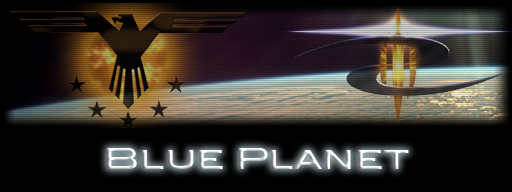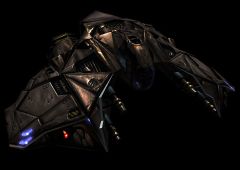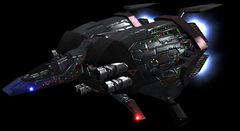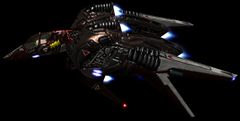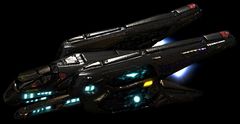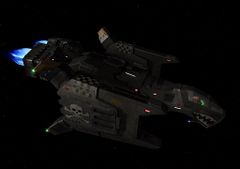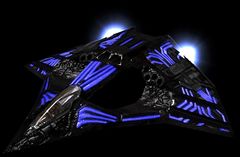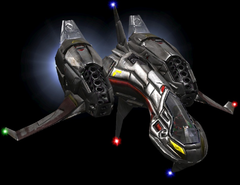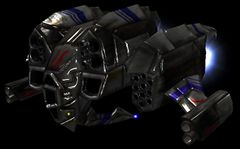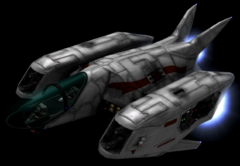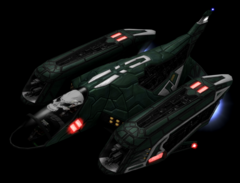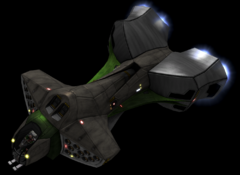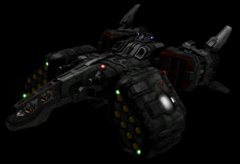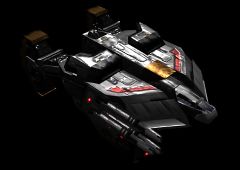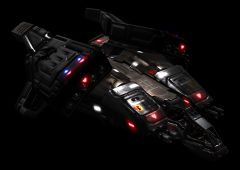Difference between revisions of "Blue Planet Extras Portal"
m (Intelligence entries.) |
(Added all non-unique weapon database entries and link to Vishnans. Category link added directly to the top of the Weapons section to link to BP weapon articles, which have already been created.) |
||
| Line 1: | Line 1: | ||
| − | + | {{BPArticle}} | |
This page lists tech room entries present in [[Blue Planet]] for reference and ease of access, as many of those do not belong anywhere else (BP descriptions of retail ships, for example, do not belong in their relevant ship pages, as only canon data should be listed there). Also add the possibility to write BP-specific veteran comments for those retail ships and weapons. | This page lists tech room entries present in [[Blue Planet]] for reference and ease of access, as many of those do not belong anywhere else (BP descriptions of retail ships, for example, do not belong in their relevant ship pages, as only canon data should be listed there). Also add the possibility to write BP-specific veteran comments for those retail ships and weapons. | ||
| Line 206: | Line 206: | ||
==Weapons== | ==Weapons== | ||
| + | :''See also: [[:Category:Blue Planet weapons]]'' | ||
| + | === Terrans === | ||
| + | ==== [[FighterKiller|SGFIM-I]] ==== | ||
| + | The Standard Guided Fighter Intercept Missile, nicknamed as FighterKiller is a light warship defensive option with minimal cost in heat or power output. 250-round munitions cells grant the SIM excellent endurance, and its munitions can engage targets out to 950 meters. Fire rate is limited to one missile per eight seconds due to ammunition feed issues. | ||
| + | |||
| + | ==== ''"Houndtooth"'' [[Terran Turret]] ==== | ||
| + | Bessimer-Kohn has manufactured countless 'Houndtooth' plasma pulse weapons. Classified as a Light Tactical Engagement System, the Houndtooth is used as a point defense gun and light attack option on Terran warships. It is compact, power efficient, and has excellent thermal characteristics, freeing up energy for subspace drive recharge and other vital functions. It is now being phased out in favor of the Sahr Corporation's pulse weapons. | ||
| + | |||
| + | ==== ''"Djinn"'' [[Terran Huge Turret]] ==== | ||
| + | The Bessimer-Kohn 'Djinn' heavy plasma pulse weapon offers enhanced range and damage at the cost of ROF and projectile speed. Considered long obsolete, the 'Djinn' remains in service only due to its low heat output and cost. Outclassed by modern pulse weapons, the Djinn is emblematic of the economic issues that have rocked the post-Capella GTVA. | ||
| + | |||
| + | ==== ''"Catbird"'' Terran Weak Turret ==== | ||
| + | A downgraded version of the Houndtooth warship plasma weapon, the Catbird is fitted to ships with power grid or heat sink problems, such as the Charybdis AWACS. Its firepower is inadequate for any conceivable tactical situation except asteroid defense, but funding for a fleet-wide replacement program has yet to materialize. | ||
| + | |||
| + | ==== ''"Phalanx"'' [[AAAf|Antifighter Beam]] ==== | ||
| + | A light beam cannon with a fast-rise capacitor system, SPAR optical targeting, and an 1800-meter magnetic bottle, the Phalanx Point Defense Beam System can rapidly and accurately engage incoming fighters and warheads with quick pulses. In warship engagements, it can be fired as a direct beam to supplement main batteries. This weapons system is critical to warship close defense doctrine. | ||
| + | |||
| + | ==== ""Phalanx"'' [[ULTRA Anti-Fighter Beam|Ultra Beam]] ==== | ||
| + | A GTI modification of the Phalanx antifighter beam, the Phalanx Bravo discards all targeting systems in favor of a supplementary mini-reactor. This gives it greatly enhanced range and rate of fire, but it must be used in conjunction with an outside targeting source like a TAG system. Experimental versions of these weapons with on-board targeting equipment are currently undergoing combat evaluation trials. | ||
| + | |||
| + | ==== ''"Forge Dove"'' [[LTerSlash|Light Beam]] ==== | ||
| + | Used on the Fenris cruiser, the much-maligned lighter cousin of the Forge Eagle tactical beam is limited by the power grid of the ship that mounts it. Incapable of prolonged individual bursts, it relies on its relatively short recharge time to compensate for its low damage output. The Forge Dove is an unhappy compromise, arguably inferior to the fusion mortar system it is mounted alongside. | ||
| + | |||
| + | ==== ''"Forge Eagle"'' [[TerSlash|Tactical Beam]] ==== | ||
| + | The RNI Tactical Beam System, codenamed 'Forge Eagle', is a mid-range tactical plasma beam with an efficiency-boosting twist. It uses a sweeping magnetic bottle to guide a relativistic plasma stream through contained arcs. Although it offers limited hull penetration, it is capable of firing even without accurate targeting solutions. Current GTVA combat doctrine calls for these weapons to be used to disarm or disable enemy vessels quickly. Forge Eagles are used as the main weapons of the flexible Deimos corvette and as a battery weapon on larger warships. | ||
| + | |||
| + | ==== ''"Pave Warden"'' [[SGreen|Light Beam]] ==== | ||
| + | The lightest tactical beam in the Terran arsenal, the Subach-Innes Cruiser Engagement System was built small and accurate, but at the cost of rate of fire. Its capacitors' long rise time, coupled with plasma core flow issues, hobble it with a 45-second charge cycle. Its compact mountings allow multiple beams to be fitted even on cruisers. | ||
| + | |||
| + | ==== ''"Crypt Hammer"'' [[BGreen|Heavy Beam]] ==== | ||
| + | The Subach-Innes Warship Engagement System, codenamed 'Crypt Hammer', was the primary GTVA destroyer beam during the Second Shivan Incursion. Reliable, accurate, easy to maintain, and highly robust, the Crypt Hammer remains a favorite of Terran warship crews. It provides the main tactical power of Orion and Hecate combatants. It has one of the lowest failure rates of any GTVA weapons system, but it produces copious heat and its mountings are bulky. | ||
| + | |||
| + | ==== [[BFGreen|Overloaded]] ''"Crypt Hammer"'' ==== | ||
| + | :''See also: [[LRBGreen]]'' | ||
| + | During its engagement with the Sathanas juggernaught, the GTVA Colossus overloaded its 'Crypt Hammer' beam emitters, forcing additional power to the magnetic bottle and increasing plasma core feed rates. Overloading beam weapons is not standard practice on GTVA warships, but as confidence in power grid and heat sink handling has increased, trained crews have begun drilling on tactical weapon overloads. This comes at the cost of subspace engine recharge and emitter endurance. | ||
| + | |||
| + | ==== ''"[[MjolnirBeam|Mjolnir]]"'' Weapons System ==== | ||
| + | The devastating RNI Mjolnir Weapons System is powered by an onboard muon-catalyzed fusion reactor. Capable of engaging destroyer-size targets as part of its intended role as a node blockade, the Mjolnir offers devastating firepower but at the cost of limited flexibility. It requires frequent maintenance due to its limited reactant supply and a tendency to burn itself out. | ||
| + | |||
| + | === Vasudans === | ||
| + | ==== [[SVas|Mkh/Akh 121b Beam System]] ==== | ||
| + | Mekhu Enterprises and the Akheton Corporation collaborated to design Vasudan beam systems, making grim but effective use of hours of scans gathered while the Lucifer bombarded Vasuda Prime. The 221b Beam System is used as a supplementary weapon on Vasudan destroyers, where it has earned high praise - it outperforms even Shivan beam weapons. Unexpected heat issues prevented it from being mounted on Vasudan cruisers, leaving them tremendously anemic against warships. | ||
| + | |||
| + | ==== [[VSlash|Mkh/Akh 183 Beam System]] ==== | ||
| + | The gap between cruiser-size and destroyer-size beam weapons is large, due to nonlinear scaling of heat sink and power requirements. Corvette-class warships demanded a middle ground. Mekhu Enterprises science teams focused on maximizing beam effect rather than power, using an arcing magnetic bottle to cut a path across the target. Due to Vasudan expertise in power grid design, the 183 outperforms its Terran equivalent by a small margin. The Sobek corvette makes good use of this weapons system. | ||
| + | |||
| + | ==== [[BVas|Mkh/Akh 255a Beam System]] ==== | ||
| + | The Mekhu/Akheton 255a destroyer-mounted heavy beam uses a coaxial sensor suite to analyze debris spall from the target and uses that data to fine-tune beam radius and velocity for maximum effect. This striking piece of technology, later implemented in next-generation beam weapons, was developed by the Akheton Corporation based on systems used in the SDG. Sophisticated but power-hungry, the 255a outperforms its Terran equivalent by a small margin. | ||
| + | |||
| + | === [[GTVA]] === | ||
| + | ==== ''"Crow Lash"'' [[Standard Flak|Flak System]] ==== | ||
| + | The flak gun is a post-Great War innovation and a key element of warship close defense doctrine. Firing caseless, smart-fused, electrically ignited explosive shells at barely subnuclear yields, the flak gun damages targets by fragmentation and blast. Modern flak guns can sustain area suppression barrages for minutes at a time before their ammunition is depleted. Although heat-efficient, flak gun deployment is limited by the need for large ammunition bunkers. One common model is the 'Crow Lash' system, is used on most GTVA warships both Terran and Vasudan. | ||
| + | |||
| + | ==== [[Fusion Mortar|Fusion Mortar System]] ==== | ||
| + | Direct-fire missile launchers firing low-yield fusion torpedoes from thousand-round revolver magazines mounted on some GTVA warships. While these weapon systems have high maintenance requirements, they can provide firepower equivalent to a light beam system with only moderate strain on a ship's power and cooling systems. The Fenris and Leviathan cruisers, as well as the Hatshepsut destroyer, are the most notable warships mounting these. | ||
| + | |||
| + | === Shivans === | ||
| + | ==== [[Shivan Cluster|Shivan Cluster Missile]] ==== | ||
| + | Shivan warships and bombers deploy cluster weapons in self defense. Launching multiple heat-seeking submunitions, these weapons appear similar to our own Piranha warheads. The warhead bus produces a shockwave that can be hazardous to nearby craft. The Nahema bomber in particular appears to employ these weapons extensively. | ||
| + | |||
| + | ==== [[Shivan Light Laser]] ==== | ||
| + | Shivan weapon systems fire particle bursts with complex effects. Kinetic and thermal damage is the primary means of attack, but the weapons are not of sufficient power to match Alliance fighter-mounted equivalents. Strangely, Shivan weapons appear to contain sophisticated quantum computational systems which allow the burst to be programmed on the atomic level. The resultant attack can actually alter the probabilistic waveforms of baryonic matter and trigger zero-point energy microbursts. This system is used by the UD-8 Kayser to devastating effect. Puzzlingly, however, the system appears to be disabled in Shivan weapons. | ||
| + | |||
| + | ==== [[Shivan Heavy Laser]] ==== | ||
| + | Shivan fighter weapons are qualitatively inferior in performance to their Alliance counterparts. Yet analysis of captured specimens has revealed that these weapons are incredibly sophisticated on the technological level, capable of yields that match or exceed the GTVA's best weapons systems. Why are Shivan weapons performing below their maximum specification? Some have postulated that the Shivans are intentionally holding back, but the merciless nature of the past two Shivan incursions renders this hypothesis unlikely. GTVI analysis continues. | ||
| + | |||
| + | ==== [[Shivan Mega Laser]] ==== | ||
| + | In recent years, elements of GTVI have suggested that the unused capabilities of Shivan weapons systems are analogous to the stretches of noncoding DNA present in the human and Vasudan genomes. In this hypothesis, the excess capabilities of Shivan weapons technologies are latent, awaiting a selective pressure that will activate them. Yet the Shivans clearly display intelligent, goal-directed behavior - why would they build weapons and then find themselves unable to use them to their full potential? This apparent paradox has yet to be resolved. | ||
| + | |||
| + | ==== [[Shivan Turret Laser|Shivan Point Defense Laser]] ==== | ||
| + | The Shivans' primary turret weapons system outperforms its Terran counterpart, the Houndtooth, in most respects. Shivan warships deploy this weapons system against incoming bombs, as a deterrent to fighters, and against hostile warships. GTVA scientists have yet to replicate the finesse of the manufacturing techniques used in this weapon. | ||
| + | |||
| + | ==== [[Shivan Weak Turret Laser|Shivan Weak Point Defense Laser]] ==== | ||
| + | Like Allied vessels, Shivan ships seem to pay careful attention to power usage and heat regulation. This light point defense laser places minimal strain on power grids or heat sinks. It is unclear whether Shivan technology is in fact limited by these constraints, or whether Allied forces have simply yet to encounter top-of-the-line Shivan weapons. | ||
| + | |||
| + | ==== [[Shivan Megafunk Turret|Shivan Assault Plasma System]] ==== | ||
| + | Firing excited plasma drawn directly from onboard reactors and barely confined by a projected magnetic bottle, this massive turret weapon is a serious threat to unshielded targets. Loose bolt cohesion, and the slow travel speed necessitated by the turret's magnetic manipulation, lessen its effectiveness against well-shielded or agile targets. GTI analysts have suggested that these weapons may be downgraded or crippled versions of Shivan beam weapons - begging the question of why they appeared in the Great War. | ||
| + | |||
| + | ==== [[SAAA|Shivan Antifighter Beam]] ==== | ||
| + | Anti-fighter beams were developed after the Great War, a result of improvements in magnetic bottle technology and low-rise-time capacitors. Why did the Shivans of the Second Incursion suddenly possess this technology? Did they develop it in parallel? Why does Shivan technology display such inconsistent levels of sophistication? These questions remain unanswered. The Shivan anti-fighter weapons system is capable of near-continuous fire at slightly reduced energy levels compared to its GTVA equivalent. | ||
| + | |||
| + | ==== [[Shivan Super Laser]] ==== | ||
| + | The Lucifer's primary weapon systems were later identified as beam cannons of immense power. Driven by five onboard reactors, these weapons made short work of Allied warships. Tragically, they could also be adapted to fire on planetary targets for hours at a time, a task at which they excelled. | ||
| + | |||
| + | ==== [[SRed|Shivan Light Beam Cannon]] ==== | ||
| + | Alliance beam cannons were reverse-engineered from scans of the Lucifer. Shivan beam weapons systems continue to outperform them, offering comparable or superior firepower with reduced power drain and heat output. This beam cannon is a cruiser-grade weapons system used for direct-fire engagement of hostile targets. It is a serious but not overwhelming threat to Allied warships. Pilots who see a charging beam should break to avoid its path. | ||
| + | |||
| + | ==== [[LRed|Shivan Heavy Beam Cannon]] ==== | ||
| + | The hellishly powerful Shivan destroyer-grade beam system annihilates layers of collapsed molybdenum armor with contemptuous ease. Firing a jet of tightly contained plasma at relativistic velocities, this beam system overmatches any warship in the GTVA arsenal. The heavy beam cannon is integral to Shivan shock-jump tactics, and provides a near-insurmountable advantage in line engagements. It is capable of near-continuous fire, and yet, frighteningly, its power requirements are so low that it can be mounted on modified cruisers. Ships carrying these weapons should be considered priority targets for disarming strikes. | ||
| + | |||
| + | ==== [[BFRed|Shivan Juggernaut Beam Cannon]] ==== | ||
| + | Alliance analysts have no explanation for this weapons system. The Sathanas' main beam cannons discharge kilotons of magnetically confined plasma at .9998 lightspeed. They are capable of continuous fire without overheating. It is unclear where the heat goes, leading GTI analysts to the unsettling conclusion that these weapons are not compatible with thermodynamics as we understand it. It is possible that waste heat is somehow shunted into subspace, or that the Shivans use quantum sleight-of-hand to process the heat out of local space. No allied warship can survive engagement with one of these weapons. Current GTVA tactical doctrine calls for concentrated bomber strikes to destroy these weapons before they can be brought to bear on allied capital ships. | ||
==Intelligence== | ==Intelligence== | ||
| − | + | :''See also: [[Vishnans]]'' | |
===The Second Incursion=== | ===The Second Incursion=== | ||
| Line 218: | Line 310: | ||
===Project Nagari, Parts 1 and 2=== | ===Project Nagari, Parts 1 and 2=== | ||
| − | |||
| − | |||
| − | |||
| − | |||
===The Reunion, Parts 1 and 2=== | ===The Reunion, Parts 1 and 2=== | ||
Revision as of 18:01, 11 September 2012
| The following information has not been confirmed by Volition and is therefore not canon for the FreeSpace universe. |
|---|
This page lists tech room entries present in Blue Planet for reference and ease of access, as many of those do not belong anywhere else (BP descriptions of retail ships, for example, do not belong in their relevant ship pages, as only canon data should be listed there). Also add the possibility to write BP-specific veteran comments for those retail ships and weapons.
Contents
- 1 Ships
- 1.1 GTVA Terran ships
- 1.2 Weapons
- 1.2.1 Terrans
- 1.2.1.1 SGFIM-I
- 1.2.1.2 "Houndtooth" Terran Turret
- 1.2.1.3 "Djinn" Terran Huge Turret
- 1.2.1.4 "Catbird" Terran Weak Turret
- 1.2.1.5 "Phalanx" Antifighter Beam
- 1.2.1.6 ""Phalanx" Ultra Beam
- 1.2.1.7 "Forge Dove" Light Beam
- 1.2.1.8 "Forge Eagle" Tactical Beam
- 1.2.1.9 "Pave Warden" Light Beam
- 1.2.1.10 "Crypt Hammer" Heavy Beam
- 1.2.1.11 Overloaded "Crypt Hammer"
- 1.2.1.12 "Mjolnir" Weapons System
- 1.2.2 Vasudans
- 1.2.3 GTVA
- 1.2.4 Shivans
- 1.2.4.1 Shivan Cluster Missile
- 1.2.4.2 Shivan Light Laser
- 1.2.4.3 Shivan Heavy Laser
- 1.2.4.4 Shivan Mega Laser
- 1.2.4.5 Shivan Point Defense Laser
- 1.2.4.6 Shivan Weak Point Defense Laser
- 1.2.4.7 Shivan Assault Plasma System
- 1.2.4.8 Shivan Antifighter Beam
- 1.2.4.9 Shivan Super Laser
- 1.2.4.10 Shivan Light Beam Cannon
- 1.2.4.11 Shivan Heavy Beam Cannon
- 1.2.4.12 Shivan Juggernaut Beam Cannon
- 1.2.1 Terrans
- 1.3 Intelligence
- 1.3.1 The Second Incursion
- 1.3.2 The Post-Capella GTVA
- 1.3.3 The Rift, Parts 1 and 2
- 1.3.4 Vasudan Mysticism, Parts 1 and 2
- 1.3.5 Project Nagari, Parts 1 and 2
- 1.3.6 The Reunion, Parts 1 and 2
- 1.3.7 The Balance of Power, Parts 1 to 5
- 1.3.8 The Council of Elders
- 1.3.9 The Fedayeen
- 1.3.10 Admiral Anita Lopez
- 1.3.11 Admiral Cyrus Severanti
- 1.3.12 Admiral Chiwitel Steele
- 1.3.13 Admiral Robert Byrne
- 1.3.14 Admiral Hans Maxwell "H.M." Calder
- 1.3.15 Unknown Device Schematics (major spoilers)
Ships
GTVA Terran ships
GTF Ulysses
A product of joint Terran-Vasudan design, the Ulysses is a Great War-era light space superiority fighter renowned for its maneuverability and slim target profile. It saw limited action during the Second Shivan Incursion, serving on front-line units with the Neo-Terran Front and as a combat evaluation fighter with the GTVA. The Ulysses remains in very limited production, but has been completely retired from front-line GTVA formations.
GTF Hercules
The Hercules assault fighter was the crowning jewel of Allied fighter forces during the Great War, and it remained a favorite amongst pilots even after the introduction of its successor, the Hercules II. Many Hercules units were lost during the NTF rebellion. The Hercules has been pulled from front-line service, and production has been discontinued. Remaining spaceframes serve as targets or in security operations.
GTF Hercules Mark II
The Hercules II assault fighter sacrifices some of its predecessor's cannon firepower for a boost in secondary capacity. The modernized, hybrid spaceframe offers enhanced ordnance bays and a sophisticated fire control computer. The Hercules II performed well during its OpEval period and, despite casualties during the Second Shivan Incursion, was judged a success in its assigned role attacking lightly defended targets and cruisers. However, the introduction of the Ares spaceframe, a modified Hercules II, has limited Hercules II deployment in the true heavy assault role. Hercules II fighters are used as skirmishers against lightly defended convoys, and as heavy missile pickets on escort missions.
GTF Ares
The Ares was the result of a crash program to rebuild the Hercules Mark 2 as a heavily armored missile boat. Slower and clumsier than its base model, the Ares mounts depleted uranium armor plating over critical subsystems, molybdenum plates, and enhanced shields. It can carry sufficient Trebuchet missiles to disarm a light warship or fend off multiple bomber wings before rearming. The Ares entered service just as the Shivans stormed Capella, and what few units were available saved thousands of lives during escort missions. Despite a stormy production history, the Ares is now a front-line combatant, used in heavy assault missions, pop-up Trebuchet strikes, and critical defensive missions. Despite its usefulness as a missile platform, it cannot dogfight effectively, and must avoid interceptors at all costs.
GTF Erinyes
The Erinyes had barely entered its OpEval period when the Second Shivan incursion began. It served with SOC units and, later, elite line squadrons, where it gained a reputation for massive firepower but low sustainability. Mounting the UD-8 Kayser probability weapon, the Erinyes' eight gun banks and good secondary capability give it tremendous killing power. But its reactor cannot handle the strain of sustained fire, and its maneuverability leaves something to be desired. Although it proved effective at massacring most Shivan fighters, and went into wide-scale production during the Threat Exigency Initiative, it remains an oddly paradoxical design - an excellent killer but a limited fighter. As agility became more and more critical to fighter design, the complex Erinyes proved impossible to re-engineer. Although it remains in service with elite squadrons for heavy space superiority missions, it will soon be superceded by the next-generation GTF Nyx.
GTF Loki
The linchpin of GTI fighter forces during Rybak's Hades Rebellion was the Loki stealth fighter. Initially an invisible nightmare, the Loki lost its main tactical advantage when a weakness in its stealth systems was discovered. It was moved into the role of scout fighter during Reconstruction, but was often pressed into the dogfight and intercept role by the Neo-Terran Front, where it earned praise for its agility but struggled to compensate for its structural weakness. The Loki has not been produced since the NTF Rebellion, and most remaining spaceframes have been sold off.
GTF Pegasus
The low-visibility, sensor-stealthed Pegasus fighter is a recon platform above all else. Operated primarily by Special Operations Command, Pegasus pilots work in pairs or alone, cruising for long cold hours or days without making telltale subspace jumps. The onboard sensor systems are adequate to the recon task, but limited by the need to maintain EMCON. Even when they must make subspace transits, Pegasus jump drives are difficult to detect or vector. Pegasus pilots gathered critical information that helped suppress brush wars after the Second Incursion, and allegedly performed deniable assassination missions.
GTF Perseus
The mainstay of the Terran fleet after the Second Incursion, the Perseus is produced on nearly every world in the Alliance and assigned to every destroyer in every battle group. Reassigned from intercept to multirole combatant after its sterling performance during the Second Incursion, the Perseus is cheap, flexible, and an excellent dogfighter and interceptor. In a pinch it can perform anti-subsystem strikes on warships with Stiletto II bombs. Even with the advent of next-generation fighters, the Perseus will remain in service for years to come.
GTF Myrmidon
The Myrmidon fighter, designed by RNI Systems to fulfill an impossibly broad request from the Admiralty, is a space superiority fighter with problematic handling, the primary firepower of an assault craft, and three secondary banks of unusual design and limited capacity. It is gradually being phased out, but still serves as a line fighter, bomber escort, and battle group guardian across the Terran elements of the Alliance fleet. Some pilots achieve a particular affinity with this unusual craft, but in general its wide target profile has given it a reputation as a pilot-killer. Captured Neo-Terran Front pilots reported that the Myrmidon was respected for its firepower but considered too clumsy for its role.
GTB Artemis
Artemis bombers were not anticipated to be a success, but after a strong showing during the NTF rebellion, they now represent the majority of the GTVA's tactical strike ability. Maneuverable and cheap, the Artemis is able to deliver its payload rapidly. Tactical analysis suggested that bombers rarely survived prolonged engagement, so the Artemis' limited warhead capacity is considered non-problematic. Without defensive turrets, the Artemis is reliant on fighter escort, but it can dogfight if pressed. This behavior is strongly discouraged during pilot training, but because Artemis bombers are often deployed with inadequate escort, it frequently becomes necessary. The bomber's single primary bank is often fitted with a Maxim cannon for supplementary firepower.
GTB Artemis D.H.
A more maneuverable variant of the Artemis bomber, the Artemis DH has seen production alongside its white-skinned cousin. It is used in the same tactical role, targeting cruisers and corvettes.
GTB Boanerges
A controversial new heavy bomber at the time of the Second Shivan Incursion, the Boanerges proved a logistical dream but a mixed blessing tactically. Heavily shielded and with a large payload, the Boanerges eschewed defensive turrets as "of limited use." Bomber pilots did not react strongly to this decision, and although the Boanerges is at least capable in its role, it still divides pilots today. Good maneuverability allows the Boanerges some success in reaching its targets, but in spite of heavy armor cannot withstand defensive fire from warships or interceptors. It is an open question whether heavy bombers will remain tactically relevant. For the moment, the Boanerges' easy maintenance, cheap assembly, and long lifespan make it common in the heavy anti-shipping and anti-installation role.
GTB Medusa
The Medusa is an obsolete Great War-era bomber. It was used in an anti-shipping role by the Neo-Terran Front, but never met with any real success. GTVA pilots considered the Medusa an ineffective deathtrap.
GTB Ursa
Fifty years after the Great War, the Ursa bomber still serves the GTVA as an inflexible but powerful anti-shipping platform. With limited speed, the Ursa struggles to reach its targets, and in spite of heavy armor it cannot survive engagement with even a single interceptor. Its large target profile renders it vulnerable to flak and beam fire. Tactical doctrine calls for Ursa deployment against destroyers after their antifighter defenses are disarmed and their fighter compliment depleted. Designers today consider the Ursa a dead end, and strive to manufacture bombers with fighter-like maneuverability and speed.
GTB Zeus
The Zeus was a GTI tactical bomber, designed for light anti-shipping work and as a tactical missile platform. For nearly twelve years after the Second Incursion, the Zeus actually remained in production to serve as a stopgap Trebuchet delivery system, as well as in its historical role carrying light warheads like the Stiletto II. The Zeus now serves as a training target and has been largely removed from service.
Weapons
- See also: Category:Blue Planet weapons
Terrans
SGFIM-I
The Standard Guided Fighter Intercept Missile, nicknamed as FighterKiller is a light warship defensive option with minimal cost in heat or power output. 250-round munitions cells grant the SIM excellent endurance, and its munitions can engage targets out to 950 meters. Fire rate is limited to one missile per eight seconds due to ammunition feed issues.
"Houndtooth" Terran Turret
Bessimer-Kohn has manufactured countless 'Houndtooth' plasma pulse weapons. Classified as a Light Tactical Engagement System, the Houndtooth is used as a point defense gun and light attack option on Terran warships. It is compact, power efficient, and has excellent thermal characteristics, freeing up energy for subspace drive recharge and other vital functions. It is now being phased out in favor of the Sahr Corporation's pulse weapons.
"Djinn" Terran Huge Turret
The Bessimer-Kohn 'Djinn' heavy plasma pulse weapon offers enhanced range and damage at the cost of ROF and projectile speed. Considered long obsolete, the 'Djinn' remains in service only due to its low heat output and cost. Outclassed by modern pulse weapons, the Djinn is emblematic of the economic issues that have rocked the post-Capella GTVA.
"Catbird" Terran Weak Turret
A downgraded version of the Houndtooth warship plasma weapon, the Catbird is fitted to ships with power grid or heat sink problems, such as the Charybdis AWACS. Its firepower is inadequate for any conceivable tactical situation except asteroid defense, but funding for a fleet-wide replacement program has yet to materialize.
"Phalanx" Antifighter Beam
A light beam cannon with a fast-rise capacitor system, SPAR optical targeting, and an 1800-meter magnetic bottle, the Phalanx Point Defense Beam System can rapidly and accurately engage incoming fighters and warheads with quick pulses. In warship engagements, it can be fired as a direct beam to supplement main batteries. This weapons system is critical to warship close defense doctrine.
""Phalanx" Ultra Beam
A GTI modification of the Phalanx antifighter beam, the Phalanx Bravo discards all targeting systems in favor of a supplementary mini-reactor. This gives it greatly enhanced range and rate of fire, but it must be used in conjunction with an outside targeting source like a TAG system. Experimental versions of these weapons with on-board targeting equipment are currently undergoing combat evaluation trials.
"Forge Dove" Light Beam
Used on the Fenris cruiser, the much-maligned lighter cousin of the Forge Eagle tactical beam is limited by the power grid of the ship that mounts it. Incapable of prolonged individual bursts, it relies on its relatively short recharge time to compensate for its low damage output. The Forge Dove is an unhappy compromise, arguably inferior to the fusion mortar system it is mounted alongside.
"Forge Eagle" Tactical Beam
The RNI Tactical Beam System, codenamed 'Forge Eagle', is a mid-range tactical plasma beam with an efficiency-boosting twist. It uses a sweeping magnetic bottle to guide a relativistic plasma stream through contained arcs. Although it offers limited hull penetration, it is capable of firing even without accurate targeting solutions. Current GTVA combat doctrine calls for these weapons to be used to disarm or disable enemy vessels quickly. Forge Eagles are used as the main weapons of the flexible Deimos corvette and as a battery weapon on larger warships.
"Pave Warden" Light Beam
The lightest tactical beam in the Terran arsenal, the Subach-Innes Cruiser Engagement System was built small and accurate, but at the cost of rate of fire. Its capacitors' long rise time, coupled with plasma core flow issues, hobble it with a 45-second charge cycle. Its compact mountings allow multiple beams to be fitted even on cruisers.
"Crypt Hammer" Heavy Beam
The Subach-Innes Warship Engagement System, codenamed 'Crypt Hammer', was the primary GTVA destroyer beam during the Second Shivan Incursion. Reliable, accurate, easy to maintain, and highly robust, the Crypt Hammer remains a favorite of Terran warship crews. It provides the main tactical power of Orion and Hecate combatants. It has one of the lowest failure rates of any GTVA weapons system, but it produces copious heat and its mountings are bulky.
Overloaded "Crypt Hammer"
- See also: LRBGreen
During its engagement with the Sathanas juggernaught, the GTVA Colossus overloaded its 'Crypt Hammer' beam emitters, forcing additional power to the magnetic bottle and increasing plasma core feed rates. Overloading beam weapons is not standard practice on GTVA warships, but as confidence in power grid and heat sink handling has increased, trained crews have begun drilling on tactical weapon overloads. This comes at the cost of subspace engine recharge and emitter endurance.
"Mjolnir" Weapons System
The devastating RNI Mjolnir Weapons System is powered by an onboard muon-catalyzed fusion reactor. Capable of engaging destroyer-size targets as part of its intended role as a node blockade, the Mjolnir offers devastating firepower but at the cost of limited flexibility. It requires frequent maintenance due to its limited reactant supply and a tendency to burn itself out.
Vasudans
Mkh/Akh 121b Beam System
Mekhu Enterprises and the Akheton Corporation collaborated to design Vasudan beam systems, making grim but effective use of hours of scans gathered while the Lucifer bombarded Vasuda Prime. The 221b Beam System is used as a supplementary weapon on Vasudan destroyers, where it has earned high praise - it outperforms even Shivan beam weapons. Unexpected heat issues prevented it from being mounted on Vasudan cruisers, leaving them tremendously anemic against warships.
Mkh/Akh 183 Beam System
The gap between cruiser-size and destroyer-size beam weapons is large, due to nonlinear scaling of heat sink and power requirements. Corvette-class warships demanded a middle ground. Mekhu Enterprises science teams focused on maximizing beam effect rather than power, using an arcing magnetic bottle to cut a path across the target. Due to Vasudan expertise in power grid design, the 183 outperforms its Terran equivalent by a small margin. The Sobek corvette makes good use of this weapons system.
Mkh/Akh 255a Beam System
The Mekhu/Akheton 255a destroyer-mounted heavy beam uses a coaxial sensor suite to analyze debris spall from the target and uses that data to fine-tune beam radius and velocity for maximum effect. This striking piece of technology, later implemented in next-generation beam weapons, was developed by the Akheton Corporation based on systems used in the SDG. Sophisticated but power-hungry, the 255a outperforms its Terran equivalent by a small margin.
GTVA
"Crow Lash" Flak System
The flak gun is a post-Great War innovation and a key element of warship close defense doctrine. Firing caseless, smart-fused, electrically ignited explosive shells at barely subnuclear yields, the flak gun damages targets by fragmentation and blast. Modern flak guns can sustain area suppression barrages for minutes at a time before their ammunition is depleted. Although heat-efficient, flak gun deployment is limited by the need for large ammunition bunkers. One common model is the 'Crow Lash' system, is used on most GTVA warships both Terran and Vasudan.
Fusion Mortar System
Direct-fire missile launchers firing low-yield fusion torpedoes from thousand-round revolver magazines mounted on some GTVA warships. While these weapon systems have high maintenance requirements, they can provide firepower equivalent to a light beam system with only moderate strain on a ship's power and cooling systems. The Fenris and Leviathan cruisers, as well as the Hatshepsut destroyer, are the most notable warships mounting these.
Shivans
Shivan Cluster Missile
Shivan warships and bombers deploy cluster weapons in self defense. Launching multiple heat-seeking submunitions, these weapons appear similar to our own Piranha warheads. The warhead bus produces a shockwave that can be hazardous to nearby craft. The Nahema bomber in particular appears to employ these weapons extensively.
Shivan Light Laser
Shivan weapon systems fire particle bursts with complex effects. Kinetic and thermal damage is the primary means of attack, but the weapons are not of sufficient power to match Alliance fighter-mounted equivalents. Strangely, Shivan weapons appear to contain sophisticated quantum computational systems which allow the burst to be programmed on the atomic level. The resultant attack can actually alter the probabilistic waveforms of baryonic matter and trigger zero-point energy microbursts. This system is used by the UD-8 Kayser to devastating effect. Puzzlingly, however, the system appears to be disabled in Shivan weapons.
Shivan Heavy Laser
Shivan fighter weapons are qualitatively inferior in performance to their Alliance counterparts. Yet analysis of captured specimens has revealed that these weapons are incredibly sophisticated on the technological level, capable of yields that match or exceed the GTVA's best weapons systems. Why are Shivan weapons performing below their maximum specification? Some have postulated that the Shivans are intentionally holding back, but the merciless nature of the past two Shivan incursions renders this hypothesis unlikely. GTVI analysis continues.
Shivan Mega Laser
In recent years, elements of GTVI have suggested that the unused capabilities of Shivan weapons systems are analogous to the stretches of noncoding DNA present in the human and Vasudan genomes. In this hypothesis, the excess capabilities of Shivan weapons technologies are latent, awaiting a selective pressure that will activate them. Yet the Shivans clearly display intelligent, goal-directed behavior - why would they build weapons and then find themselves unable to use them to their full potential? This apparent paradox has yet to be resolved.
Shivan Point Defense Laser
The Shivans' primary turret weapons system outperforms its Terran counterpart, the Houndtooth, in most respects. Shivan warships deploy this weapons system against incoming bombs, as a deterrent to fighters, and against hostile warships. GTVA scientists have yet to replicate the finesse of the manufacturing techniques used in this weapon.
Shivan Weak Point Defense Laser
Like Allied vessels, Shivan ships seem to pay careful attention to power usage and heat regulation. This light point defense laser places minimal strain on power grids or heat sinks. It is unclear whether Shivan technology is in fact limited by these constraints, or whether Allied forces have simply yet to encounter top-of-the-line Shivan weapons.
Shivan Assault Plasma System
Firing excited plasma drawn directly from onboard reactors and barely confined by a projected magnetic bottle, this massive turret weapon is a serious threat to unshielded targets. Loose bolt cohesion, and the slow travel speed necessitated by the turret's magnetic manipulation, lessen its effectiveness against well-shielded or agile targets. GTI analysts have suggested that these weapons may be downgraded or crippled versions of Shivan beam weapons - begging the question of why they appeared in the Great War.
Shivan Antifighter Beam
Anti-fighter beams were developed after the Great War, a result of improvements in magnetic bottle technology and low-rise-time capacitors. Why did the Shivans of the Second Incursion suddenly possess this technology? Did they develop it in parallel? Why does Shivan technology display such inconsistent levels of sophistication? These questions remain unanswered. The Shivan anti-fighter weapons system is capable of near-continuous fire at slightly reduced energy levels compared to its GTVA equivalent.
Shivan Super Laser
The Lucifer's primary weapon systems were later identified as beam cannons of immense power. Driven by five onboard reactors, these weapons made short work of Allied warships. Tragically, they could also be adapted to fire on planetary targets for hours at a time, a task at which they excelled.
Shivan Light Beam Cannon
Alliance beam cannons were reverse-engineered from scans of the Lucifer. Shivan beam weapons systems continue to outperform them, offering comparable or superior firepower with reduced power drain and heat output. This beam cannon is a cruiser-grade weapons system used for direct-fire engagement of hostile targets. It is a serious but not overwhelming threat to Allied warships. Pilots who see a charging beam should break to avoid its path.
Shivan Heavy Beam Cannon
The hellishly powerful Shivan destroyer-grade beam system annihilates layers of collapsed molybdenum armor with contemptuous ease. Firing a jet of tightly contained plasma at relativistic velocities, this beam system overmatches any warship in the GTVA arsenal. The heavy beam cannon is integral to Shivan shock-jump tactics, and provides a near-insurmountable advantage in line engagements. It is capable of near-continuous fire, and yet, frighteningly, its power requirements are so low that it can be mounted on modified cruisers. Ships carrying these weapons should be considered priority targets for disarming strikes.
Shivan Juggernaut Beam Cannon
Alliance analysts have no explanation for this weapons system. The Sathanas' main beam cannons discharge kilotons of magnetically confined plasma at .9998 lightspeed. They are capable of continuous fire without overheating. It is unclear where the heat goes, leading GTI analysts to the unsettling conclusion that these weapons are not compatible with thermodynamics as we understand it. It is possible that waste heat is somehow shunted into subspace, or that the Shivans use quantum sleight-of-hand to process the heat out of local space. No allied warship can survive engagement with one of these weapons. Current GTVA tactical doctrine calls for concentrated bomber strikes to destroy these weapons before they can be brought to bear on allied capital ships.
Intelligence
- See also: Vishnans
The Second Incursion
The Post-Capella GTVA
The Rift, Parts 1 and 2
Vasudan Mysticism, Parts 1 and 2
Project Nagari, Parts 1 and 2
The Reunion, Parts 1 and 2
The Balance of Power, Parts 1 to 5
The Council of Elders
The Fedayeen
Admiral Anita Lopez
Admiral Cyrus Severanti
Admiral Chiwitel Steele
Admiral Robert Byrne
Admiral Hans Maxwell "H.M." Calder
Unknown Device Schematics (major spoilers)
